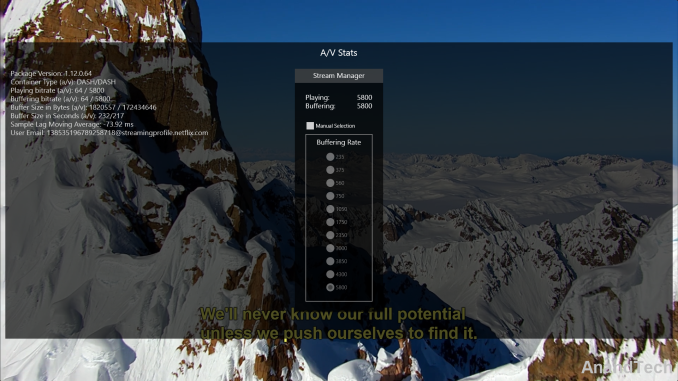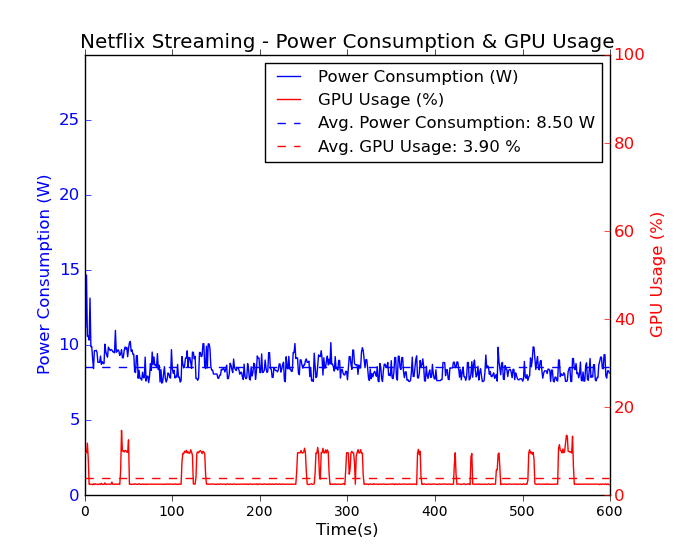Intel's Haswell NUC: D54250WYK UCFF PC Review
by Ganesh T S on January 3, 2014 4:25 PM ESTNetworking Performance and Streaming Aspects
In this section, we will take a look at the networking capabilities of the unit and also our standard HTPC streaming tests (involving YouTube and Netflix). Starting with this review, we are standardizing our evaluation of the wireless networking capabilities of UCFF and industrial PCs. Our standard test router is the Netgear R7000 Nighthawk configured with both 2.4 GHz and 5 GHz networks. The router is placed approximately 20 ft. away, separated by a drywall (as in typical US buildings). A wired client (Zotac ID89-Plus) is connected to the R7000 and serves as one endpoint for jPerf evaluation. The UCFF PC is made to connect to the two wireless SSIDs and jPerf tests are conducted for both TCP and UDP transfers with pre-set transfer parameters.
In our NUC build, Intel's Dual-Band Wireless-7260 delivers 2T2R 802.11ac speeds and provides very good throughput numbers when used with an appropriate router. As the gallery below shows, the 2.4 GHz band is able to deliver TCP throughput in the region of 86 Mbps and UDP throughput in the region of 96 Mbps.
The theoretical bandwidth number for 2x2 802.11ac is 867 Mbps. Practically, in the 5 GHz band, the 7260's TCP throughput is around 210 Mbps and UDP throughput is around 239 Mbps in our test setup.
Network Streaming Performance - Netflix and YouTube
YouTube and Netflix are two very popular streaming services utilized on HTPCs. With Windows 8, Silverlight is no longer necessary for Netflix streaming. The Netflix app on Windows 8 supports high definition streams (up to 5.8 Mbps) as well as 5.1-channel Dolby Digital Plus audio on selected titles.
It is not immediately evident whether GPU acceleration is available or not from the OSD messages. However, GPU-Z reported an average GPU utilization of 4% throughout the time that the Netflix app was playing back video. The average power consumption was around 8.5 W. Coming it at less than 10 W for the whole system while streaming HD video is very impressive. The spikes in the GPU usage were observed whenever the subtitles or control OSD kicked in. There is obviously some correlation between these spikes and the recorder power consumption at the wall.
One of the issues that I faced with the Netflix app was that bitstreaming HD audio (Dolby Digital Plus) would just not work. The playback was jerky to the point of being unwatchable and with either no or intermittent audio output to the AV receiver. Apparently, this is an issue faced by multiple users, and the problem stems from the Intel Display Audio Driver. Intel's rep on the forums, however, has been unable to reproduce the issue. So, it looks like many users are being left high and dry, unable to take advantage of one of the most important aspects of running Netflix as a Metro app.
Unlike Silverlight, Adobe Flash continues to maintain some relevance right now. YouTube continues to use Adobe Flash to serve FLV (at SD resolutions) and MP4 (at both SD and HD resolutions) streams. YouTube's debug OSD indicates whether hardware acceleration is being used or not.
Despite Windows 8 having plenty of YouTube apps, the browser interface is pretty much functional and free of external intrusive ads. The graph below shows the power consumption and GPU loading when playing a YouTube video in full screen using the Adobe Flash plugin on Mozilla Firefox.
The average GPU load is pretty constant around 8%, but power consumption at the wall has spikes corresponding to bursts of network activity. These bursts die down towards the end, after the full video gets buffered.
We saw that Haswell provided great power benefits for such network streaming activities in our HTPC piece at launch time. The Intel NUC takes this power benefit one step further by using a ULV processor. With a power consumption of less than 10 W for these activities, we are approaching dedicated media streamers' territory with the added flexibility of a full-blown PC at one's disposal.




















107 Comments
View All Comments
fluxtatic - Sunday, January 5, 2014 - link
I realize the crowd here skews a little different, but consider Linux' marketshare at less than 2%. Not to mention the endless whining - "Ubuntu sucks, test it under Mint" "Don't use kiddie distros, use Debian" "I thought you were teh hardc0r3z, use Arch" etc, etc, ad infinitum.I kid, I kid. But seriously, probably more work than it's worth, really, since you would essentially be nearly doubling the work of reviews, and it would split half the work for 90% of the market, half the work for the remaining 10% (round up on Linux marketshare to an even 2% and say it's maybe 5x more common amongst the AT crowd.)
stratum - Monday, January 6, 2014 - link
Well, I want Linux content so I'm asking for it. If enough people ask nicely then maybe one day AnandTech will provide more Linux content.Also, it's not just the Linux crowd who talk about being "l33t" and all that. I see it a lot among PC builders (many of them comment here as well) who like adding useless LEDs to everything and talk about how cool their water cooling solution is especially because it has LEDs on it. The same with video encoding, video playback and anything where you can categorize yourself in. Whatever topic you talk about, there are always going to be a group of immature people who think they're superior to everyone else.
stratum - Monday, January 6, 2014 - link
As for the whole market share thing. Just look at the articles here on AnandTech. What percent of the population or even just the readers of this site actually do OpenCL/CUDA programming, use 10 GbE NAS's and switches, rackmount anything, $5000 workstations, administrate servers, etc. yet AnandTech writes articles about them?shank15217 - Saturday, January 4, 2014 - link
These things, NUC, BRIX, Nano would be so much more useful if they have 2 NICs!!signorBlu - Monday, January 6, 2014 - link
Some Zotac ZBox models do have 2 NICs...barleyguy - Saturday, January 4, 2014 - link
Any idea how this compares to a Mac Mini, in performance, power consumption, fan noise, and features? It seems like that would be a competing solution for many of the same uses.jason64 - Saturday, January 4, 2014 - link
Yes, please hire a Linux guy for Linux articles. Also, have him come up with tests for integration with component and system reviews.Thank you.
NAC - Saturday, January 4, 2014 - link
In my opinion, these NUC computers are still way too expensive for what you get. For less than $680, you can get a laptop with i5, a SSD, memory and wifi - not to mention the screen, keyboard, battery, operating system installed, optical drive if you want, and ability to use it anywhere when you want. Granted, a laptop is much bigger and heavier. But if you are willing and able to build a NUC, you can easily build a small shelf for a laptop in the back of a desk or somewhere, hidden out of sight just like a NUC.When I replaced my HTPC, I chose a refurbished i3 laptop for about $220 delivered. It is usually in a cabinet, and I can take it with me when I travel if I want.
Lundmark - Saturday, January 4, 2014 - link
Well, I guess there will always be people arguing for hotdogs because they serve the same purpose as sirloin steak.Calista - Sunday, January 5, 2014 - link
For those of us with a big tv or projector having a small second screen make a lot of sense. If I only wish to play music, why should I have my 60" tv turned on? NAC is right, if a similar laptop is $500, why does the NUC cost more for less?